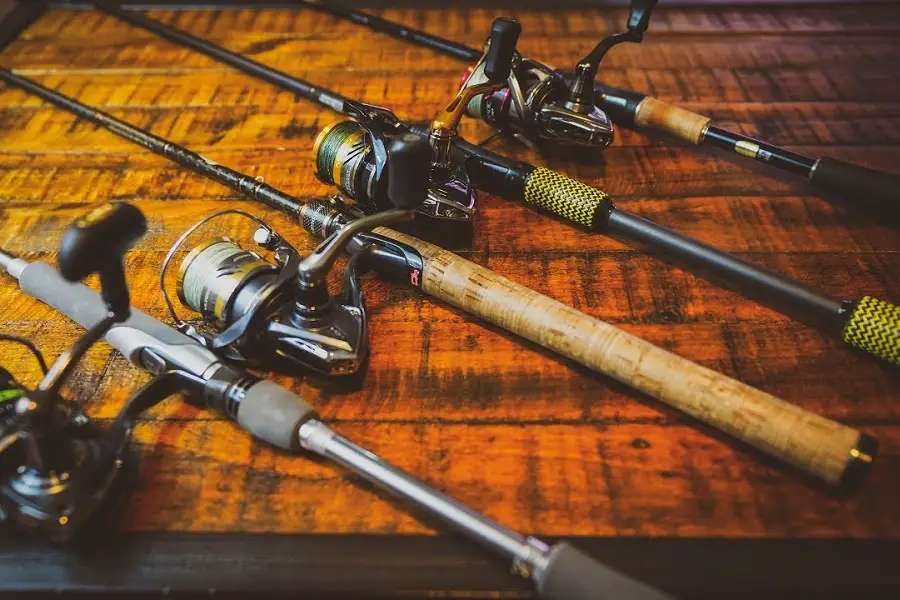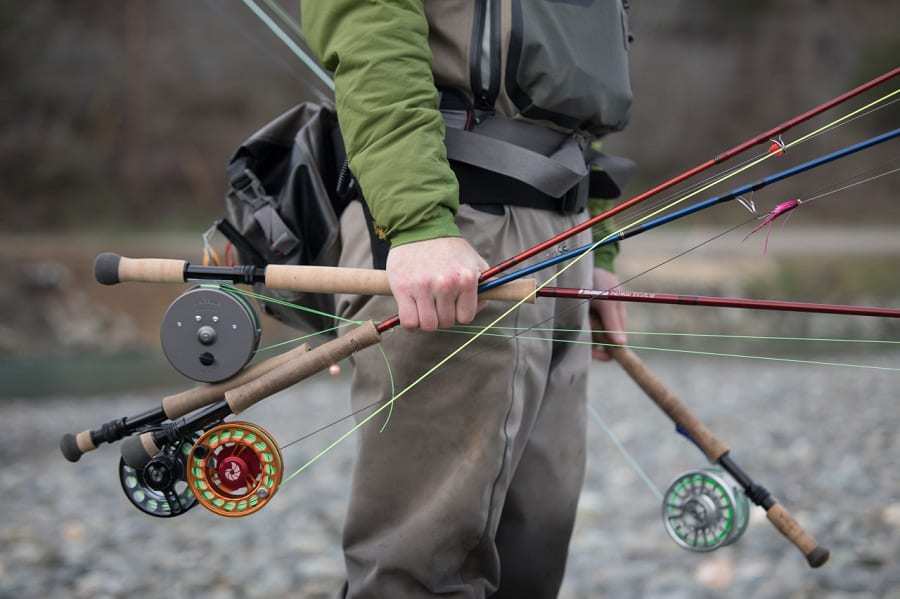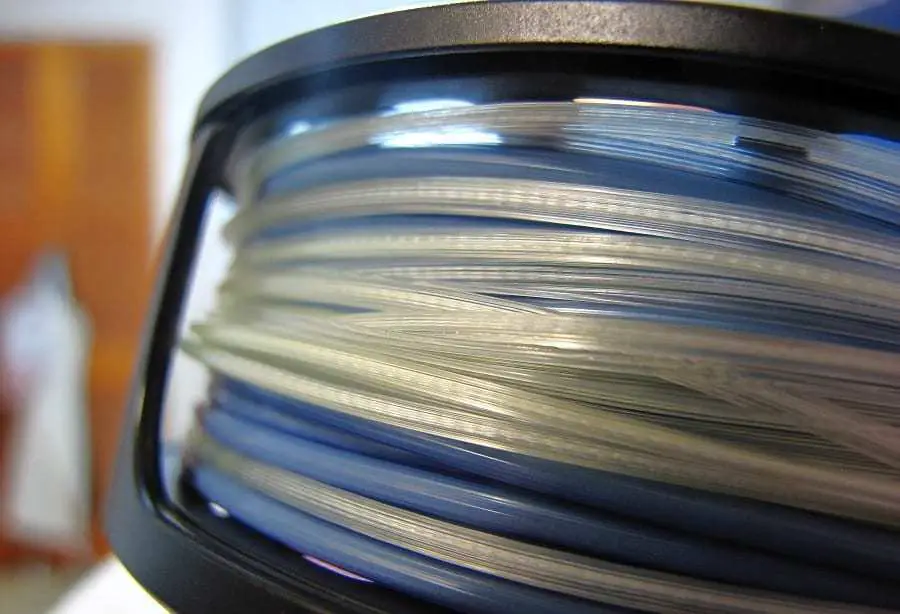(A guide to the different parts of a fishing rod, explained in detail for those starting out on their fishing journey)
If you’re new to the world of fishing and are starting out as a beginner angler, you will very quickly realize that a lot of gear and equipment is needed in order to go fishing and be successful.
But the most important tool and piece of equipment of all, without a shadow of a doubt, is the fishing rod. After all, you can’t fish without it, and it’s what connects the angler to the potential catch!
It is no wonder, therefore, that anglers pay a lot of attention to their fishing rod. There are many different options, with multiple different designs, materials, accessories, and more.
And as an angler, you need to know your fishing rod like the back of your hand, so that you fully understand it and can make the most out of its potential.
At first, the fishing rod can be quite complicated, as there are many different parts, with different names and functions. It can be a bit of a struggle to memorize them all!
But over time, you will get to know each part incredibly well, so that you can truly fish to the best of your abilities.
To help you out at the start of your fishing journey, we have created a guide to the different parts of a fishing rod, all of them explained in detail so that you can understand their function.
Does that sound good? Then let’s get right into it!
The parts of a fishing rod
In order to explain the parts of a fishing rod, we will go through every main part individually, explaining them one by one. We will start with the parts of the top half of the fishing rod and then continue with those at the bottom half.
But before we get into each different part of a fishing rod, here is a handy diagram, with all of the main parts, clearly labeled, so that you get a visual:
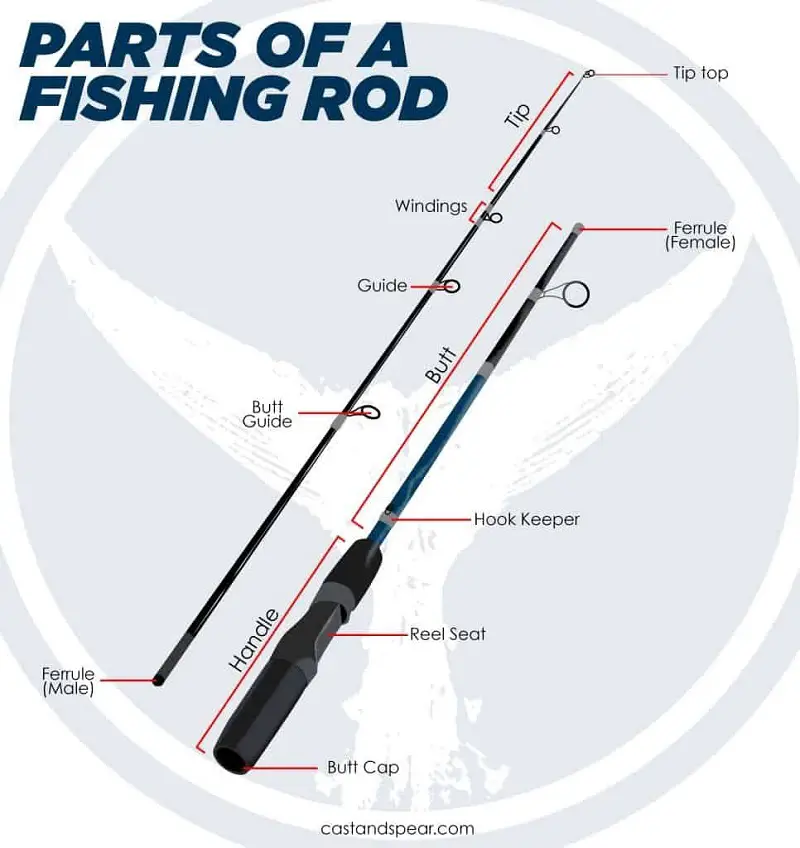
Now that you have a bit of a visual, you’ll be able to follow along with the explanations a bit better, as you’ll be able to identify where each part of the rod is on the fishing rod as a whole.
Let’s get properly started!
Tip Top

The Tip Top is the part of the fishing rod right at the very tip, which is a metal guide. You can’t get a reel lure past this point, and it prevents tangles so that the rod is kept together in a functioning manner.
The tip top is the smallest part of the rod, as a general rule, and it is also one of the most likely to break off due to it being quite fragile.
This is why it is very important to take extra care with the tip top of the fishing rod, especially while you are traveling with it.
If you do break it off accidentally, which happens quite often, it should be fairly easy to repair, but it’s still annoying and best if avoided!
The tip top of the rod is also very important when it comes to the action of the fishing rod as a whole. So the bend and flexibility of the rod when it is “loaded” with a fish or lure.
Medium action rods, for example, which is very common, are quite bendy all across the length of the rod. Fast action rods, on the other hand, are a lot stiffer.
And as we’re saying, the tip top has a lot to do with this, so it’s rather important!
Tip
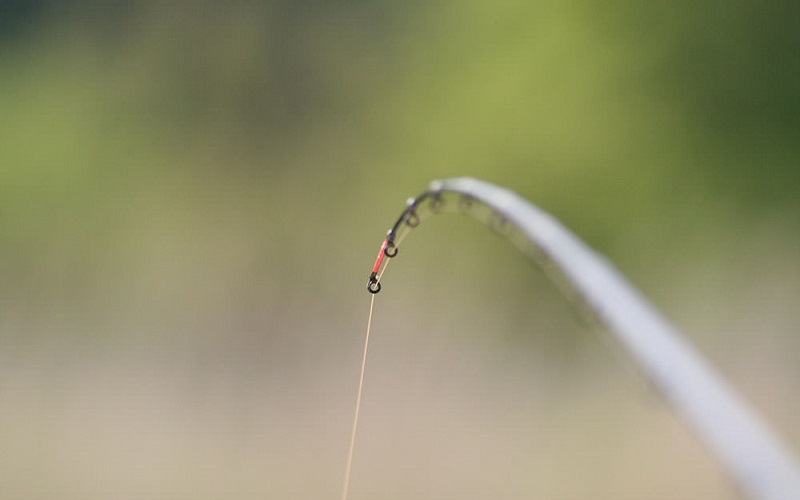
The tip is the upper part of the fishing rod, just below the tip top. This is by far the most flexible part of the entire fishing rod and the one that curves the most.
Traditionally, this part of the rod was made out of bamboo, as this material is very flexible, and it allowed for great accuracy when throwing the bait out.
However, nowadays this part of the rod is most often made out of either fiberglass or graphite metal.
The tip of the rod is important because it is usually used to measure the rod, by comparing it to its opposite end.
Plus, there are different types of tips: soft or hard, which can affect the overall action of the rod. So a hard tip is stronger, for example, while a soft tip is more flexible.
The type of tip that you choose will completely depend on your fishing style, the use you are planning to give to your rod and your personal preference.
But as a general rule, they use hard tips for deep sea fishing, as they are a lot better for catching heavy and big fish!
Windings
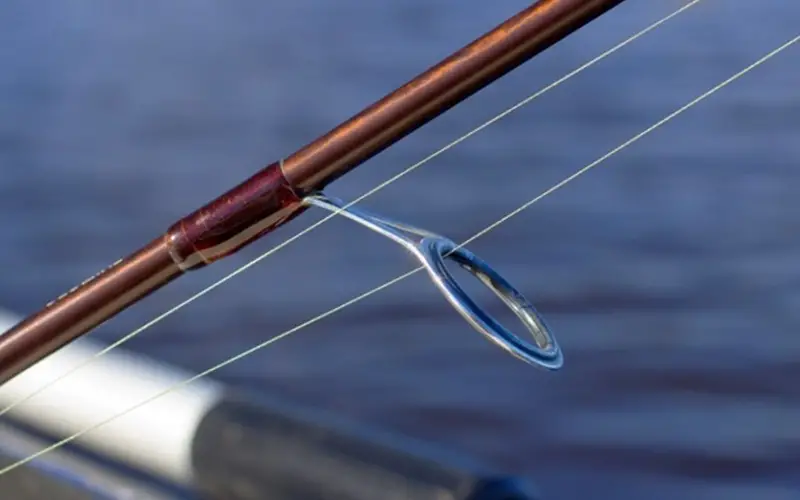
The windings are, as a general rule, made out of a string or similar material, and they are wound up around the rod guides so that they go along the body of the fishing rod.
They are most often affixed with glue or adhesive, and then painted so that they are protected, and so that they look good.
The purpose of the windings is essentially to stop the guides from being ripped off the rod because they reduce the friction of the line on the reel.
They might not seem very important, as anglers don’t really talk much about them and they don’t really affect the performance.
But they are very important as a supporting part of the rod, as they allow the rod to continue functioning in top condition.
The best kind of windings that we recommend are the ones encased in enamel, as they are strong and able to handle many different lines, no matter the amount of friction.
Guide and Hook Keeper

The guides are positioned along the length of the fishing rod, and they are essentially cylindrical shapes that keep the line going from the reel to the tip, as close to the body as possible.
They can be made with all sorts of materials, with some aiming to decrease the friction of the line.
The guides are 100% vital for the fishing rod to work properly, as they ensure the line is close to the body of the rod so that it can be cast with ease.
Also, the better the quality of the guides, the smoother the line will move, and the less it will tangle!
It is worth noting that different types of fishing rods will have different numbers of guides, spaced at different intervals, and in different positions.
This can directly affect the action of the rod, and the casting mechanism.
As for the hook keeper, it is a metal ring positioned on the body of the rod, where anglers hook the line when not fishing.
So it’s kind of a ring in which to attach the line when it’s not being used, to keep everything untangled and in place. They are used mainly when transporting the rod.
Ferrule
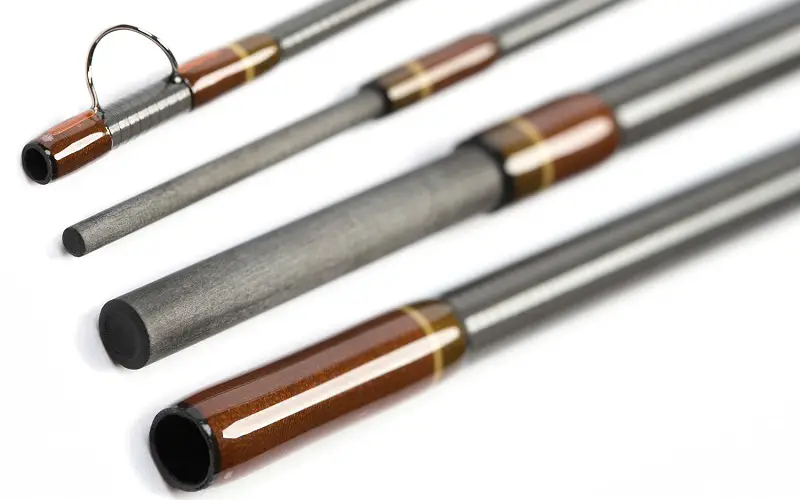
The Ferrule of a fishing rod is a part that is only seen in multi-jointed rods, which are not single-piece units.
Most beginner rods, for example, have a ferrule, because they are made out of various pieces that are joined together.
And the meeting point between the separate parts, where they join to create the full rod, is what is known as the ferrule.
Ferrules can be male or female. Male ferrules fit into the joint of another piece, to extend the length, and female ferrules are the ones that receive the other ferrule.
So it essentially makes reference to the way in which they are fitted together.
Ferrules are quite important because they ensure that the parts of the rod come together and remain stable so that the rod can be used properly.
They need to be strong so that the rod doesn’t fall apart when you’re fishing! Of course, if the rod is a single piece, then there are no ferrules needed.
When you dismantle or put together a fishing rod divided into several parts, you need to be very careful, and ensure that the ferrule is in top condition.
Butt
The butt of a fishing rod is the part of the rod located closest to the handle at the bottom, and it is also usually the thickest part of all. Sometimes it is also known as the “end” part.
Usually, the butt will have additional metal components, so that it can be twinned with a rod holder, that way you don’t have to work the rod with your hands constantly.
Sometimes, the rod holder is on the butt, so that it can be transported with more ease. But there are many different designs depending on the type of fishing rod.
Butt Cap
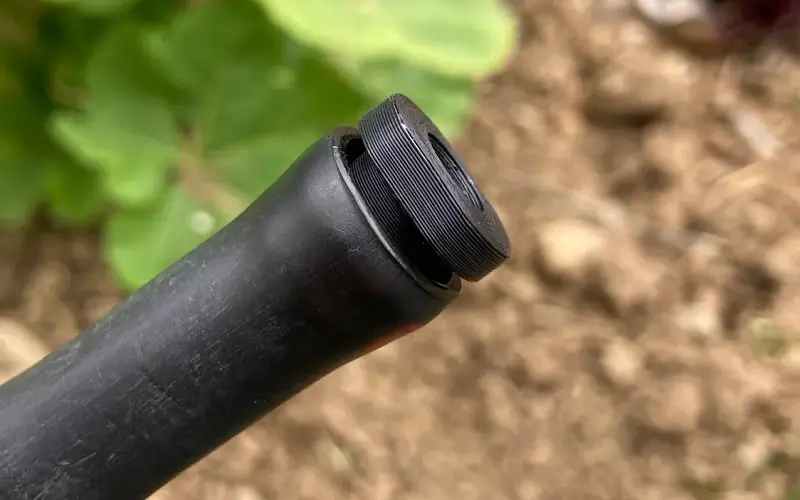
The Butt Cap is basically the opposite of the tip top, as it is the bottom end of the fishing rod. Usually, the butt cap is made out of rubber or cork, or any other material that is soft.
This is because the butt cap is often positioned against your body while you are fishing, in order to have enough strength to pull out the bigger fish.
Butt caps also often are protected with covers or guards, so that they don’t get worn down or damaged with use, especially if the fishing rod is used in bad weather conditions, or on a daily basis.
It protects the bottom end of the fishing rod and provides support when fishing, and therefore they are quite important!
Handle
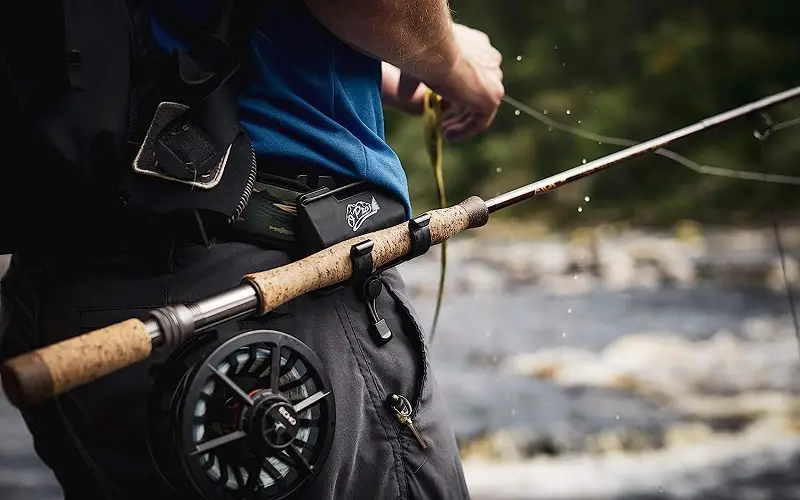
The handle is the part of the fishing rod that you hold with your hands, and it is your point of contact when fishing.
It is where weight distribution is the most important, as it is through the handle where you can feel for twitches, pulls, and pushes, so you know when to reel in the catch.
They are the main point between you and the fishing rod, and therefore the fish.
The handle is very important, and one of the main things to look out for is comfort, and for it to be anti-slip. Comfortable because it is what you are holding on to, for hours on end. And anti-slip because you need to have a good grip!
Usually, handles are made out of rubber, as this is a cheap and durable material, comfortable for most. However, if you’re looking for a more premium handle, then look for one made out of cork!
There are also many handles made out of EVA foam. For beginners, we recommend prioritizing comfort, and the grip and exact material will come with experience, as you develop your personal fishing style.
Reel Seat
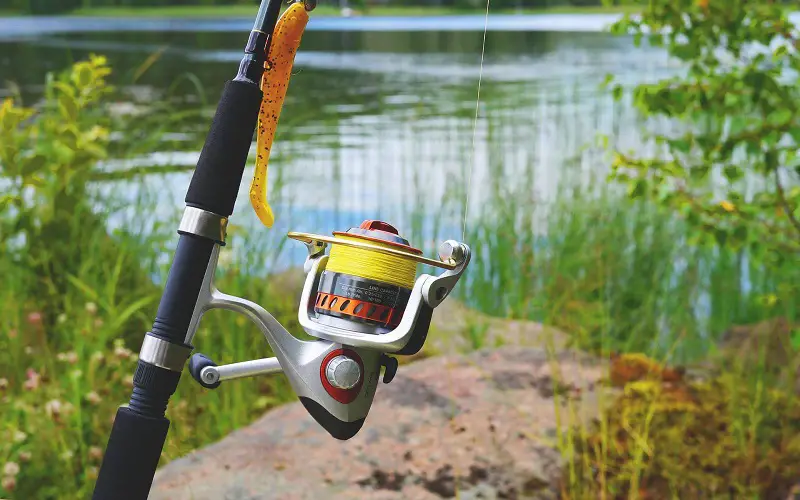
The reel seat is one of the most important parts of a fishing rod, as it is the main component in charge of casting the line and reeling it in. It is essentially where the fishing line is housed, and where the rod is positioned.
Reel seats can have different designs and compositions, depending on the type of rod that you use, as well as the length and weight of the fishing rod as a whole.
It is very important to have the right reel seat for your rod and fishing style, in order to improve your chances of success!
Also, most rods will have what is known as a hood mechanism, which keeps the reel foot in the seat.
Usually through the use of metal or plastic that is screwed in, keeping the reel and rod together. But again, this completely depends on the design of the reel seat that you have on your fishing rod!
The Blank
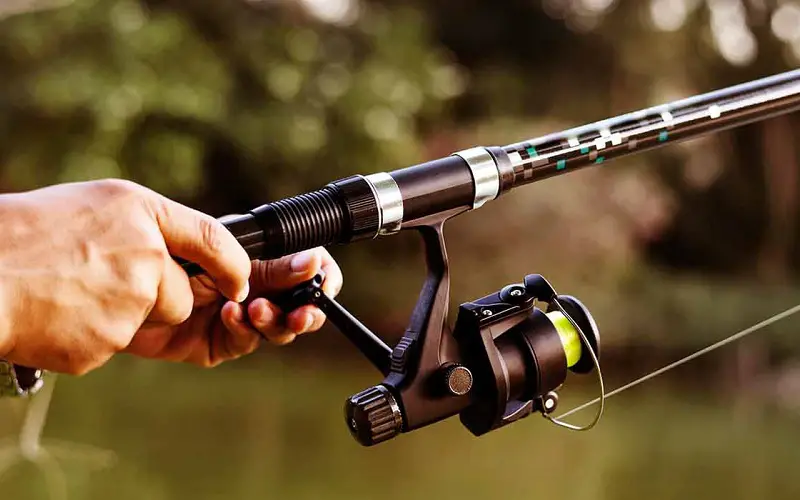
The blank is essentially just the pole of the rod, or what is also often referred to as the body. Basically, the stick upon which all of the different parts of the fishing road are affixed to.
The blank can be made out of many different materials, with the most common being fiberglass and graphite.
Anglers will have their own preference, as different materials have different advantages and disadvantages, regarding weight, power, and flexibility.
Usually, graphite blanks are better for power, as they are more rigid, and fiberglass is better for fast action as they are flexible and light.
But it completely depends on your fishing style and your personal preference!
The Rod
The rod is one of the most important components of a fishing rod, and it is very important to consider your fishing style and technique when choosing the right one for you.
There are many designs and many specific rods that are suited to certain types of fishing, such as ice fishing rods.
There are many variations, with different materials and components, and anglers will slowly figure out which rods they like best, based on their experiences and technique.
Summary
In conclusion, the main parts of a fishing rod are the Tip Top, the Tip, the Windings, the Guide and Hook Keeper, the Ferrule, the Butt, the Butt Cap, the Handle, the Reel Seat, the Blank, and the Rod.
Each part has its use and purpose, and each part can also be designed in many different ways, making use of different materials and additional accessories.
As a beginner, you should prioritize comfort and practicality. But as you gain experience, you will adapt all of the parts of the fishing rod to your own personal style of fishing, and preference.
It can be tricky to know all of the different parts of the fishing rod at first, but it’s important to get to know them all in detail so that you know exactly how your fishing rod works, and how to optimize it so that you’re getting the most out of its potential.
References:


